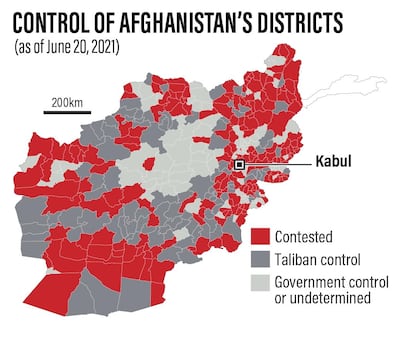For nearly 10 days, Private Fazulrahman Salangi's battalion held off a Taliban attack in Anaar Dara district of Afghanistan's Farah province, waiting for reinforcements. Finally, the group of about 40 soldiers decided to pull back, allowing the militants to overrun the district centre.
By early the next morning, videos showing the Taliban’s destruction of infrastructure and buildings in the district had gone viral on Afghan social media, fuelling the growing criticism of the government's military strategy.
“We held on for as long as we could. We asked for more ammunitions and reinforcement, but no one came,” said Pvt Salangi, 23.
The soldiers decided to retreat after two of them were killed and three others were injured, he said, speaking to The National an Afghan Army base on a hill close to the district they left behind.
“The situation was getting worse as the Taliban were getting closer,” he said. “They are no longer using just Kalashnikov rifles, but are armed with heavy weapons and Humvees.”
Faced with increased attacks and mounting losses to the Taliban, President Ashraf Ghani on Saturday appointed new heads of the interior and defence ministries and a new army chief.
The war in Afghanistan – in pictures
Interior minister Hayatullah Hayat was replaced by Abdul Mirzakwal barely three months after his appointment. Mr Ghani appointed Bismillah Mohammadi as defence minister after Assadullah Khalid resigned because of poor health, and replaced Gen Yasin Zia with Gen Wali Ahmadzai as army chief.
Mr Mohammadi on Monday called for civilians to mobilise and fight alongside security forces. "The government is ready to provide the necessary support to the people’s forces against the Taliban," he told parliament.
According to the latest UN report, the Taliban now contest or control an estimated 50 to 70 per cent of Afghan territory outside of urban centres, while also exerting direct control over 57 per cent of district administrative centres.
The militants have intensified attacks as a US-led Nato support mission prepares to pull its troops out of Afghanistan this year. Through local news reports and witness accounts, The National has counted 24 districts across 15 provinces that the Taliban has seized in the past month after Afghan forces retreated. According to the Long War Journal, the Taliban have overrun more than 30 districts since the US withdrawal began on May 1, increasing their territory from 73 districts to 105.

The government says the losses are “tactical retreats”.
“A tactical retreat is aimed at bringing Taliban out of the civilian territories and compounds they use to hide, to reduce civilian casualties and to inflict heavy casualties on them once they are out and gathered [at the district centres],” said Javid Faisal, adviser to the Afghan National Security Council.
But Orzala Nemat, director of the Afghanistan Research and Evaluation Unit in Kabul, says the strategy results in tremendous damage to national assets and administration centres.
“This so-called tactical retreat, which is basically planning to gather the Taliban to a district headquarter and bombing them for the sky, is not a responsible approach,” she said.
However, Ms Nemat also pointed out that control over the buildings that house the district government was not an absolute measure of control.
“We know from our research that control of a district, does not mean a real monopoly over the governance of that area,” she said. “So when you hear of the fall of districts, it is at times just the fall of that one building you saw in that video,” she said, referring to the viral video clip from Farah province.
“Of the nearly 400 districts, I have concrete information that in many districts that are formally under government control the locals have never received any government services or seen officials working there. For the people of that district, it does not matter who controls the area,” she said.
The lines of control and influence between the warring parties are constantly shifting, as are the alliances among local power-brokers, but the Taliban’s recent gains have alarmed some Afghan leaders.
"This is a failure partly by the government who were unable to form a consensus to bring all the different Afghan factions on the same page," Atta Mohammad Noor, leader of the Jamiat-e-Islami party told The National.
Mr Noor, a prominent leader of the Mujahideen anti-Soviet resistance and a former governor of Balkh province, called for former resistance factions and the government to build a united front against the Taliban, whether on the battlefield or in negotiations.
“There has been a failure on that front, but even now there is time to make a consolidated front to face this crisis. Because at the end of the day, we are all invested in a stable and peaceful Afghanistan,” he said.
Mr Javid, the national security adviser, said a government plan was already under way to retake the districts and that "Taliban positions, leaders and fighters have been identified" for targeting.
The government has been able to reclaim lost districts, most recently Khanabad in Kunduz province on June 14, two days after it fell to the Taliban.
However, troops on the extremely volatile and fluid front lines remain overwhelmed by the Taliban attacks.
“We could have held on to the district if only they had sent us some more ammunition and forces. We were fighting a heavily armed enemy with empty hands,” Pvt Salangi said.




















